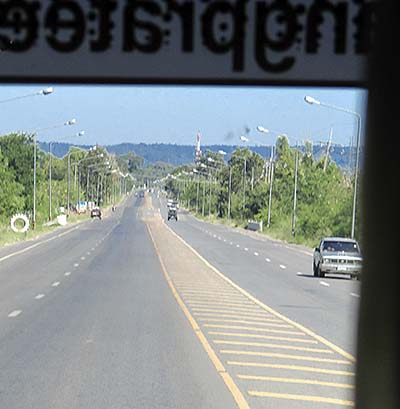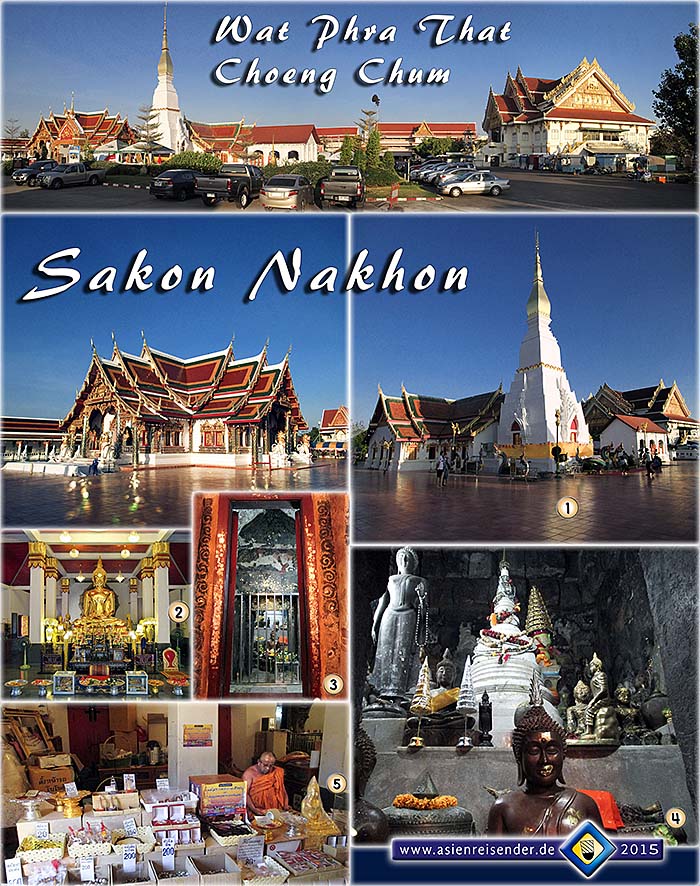Sakon Nakhon
The city of Sakon Nakhon lies in Thailand's northeastern region Isan, on the Khorat Plateau. It's the capital of the province Sakon Nakhon and bigger than most of the other cities in the region. However, the given number of inhabitants vary largely between 54,000 and 76,000.
Nong Han Lake

Nong Han Lake is flat and over large parts overgrown with water lilies (lotus). The amphibian vehicle is clearing parts of the lake's surface from the plants. Image by Asienreisender, 11/2015
A peculiarity of Sakon Nakhon city is that it borders a huge sweetwater lake, Nong Han, which covers an area of about 125km2 and is the largest sweetwater lake in Isan. It reminds somewhat to the Songkhla Lake (Chain), which is the largest lake in Thailand, but consists of different degrees of brackish water, for the Songkhla Lake has a connection to the Gulf of Thailand. A closer comparison would be the Yonok Wetlands near Chiang Saen. Nong Han is not deeper than three to six meters and has some islets. On one of them is a pagoda placed.
The lake is economically exploited by fisheries.
Along the lake's shore are a few recreation buildings and some trees, mostly casuarines. At the northeastern edge of town, bordering the lake's shores, are some bigger pools in which fish is bred and some bigger ponds whith more fish. The biggest one is in the center of a recreation park (Chaloem-Phra-Kiat-Park), where locals go in the evenings for having excercises. A gymnasium with training facilities is also in the park.
Nong Han Lake, Sakon Nakhon

At the western shore, a few kilometers out of town, a long dam connects an islet with the mainland. From here one gets a good view over the lake. Since it's quiet here, there are waterfowl to see as well. A very few single fishermen are active here. Image by Asienreisender, 11/2015
In 2011 Phu Phan Museum opened at the lake's shore. The museum is pretty large and shows the history of the province, starting with the excavations of dinosaurs (see also the Kalasin Dinosaur Museum) and gives an introduction to the Seri Thai resistance in the Second World War. There is some old pottery shown from prehistorical burial sites in the province what seems to be related to the famous findings at Ban Chiang near Udon Thani. The last, not small part of the museum is reserved for palace propaganda.
What the museum doesn't mention is the history of the very significant communist movement in Thailand, which lasted from the late 1950s on until the 1980s and happened partially also in this region.
In the museum is also a small cinema where films on the province are shown (also in English). In a separate building is a planetarium with an about 12 minutes show. It's all for free and I got even a free museums guide who explained me everything in English.
Phu Pan Mountain Range

Approaching the Phu Pan Mountains by bus on route 213 from the southwest, Kalasin Province. Image by Asienreisender, 11/2015
The southwest of the province is dominated by the Phu Pan Mountain range bordering Kalasin Province. Along the road 213 between Kalasin and Sakon Nakhon is much teak forest, but all of it secondary forest, means smaller, younger trees. The road is not particularly steep in the mountains, but at some parts are serpentines. The Phu Pan Mountains are the source of many smaller rivers who drain into the plains north and south. The mountain chain also separates the southern part of Isan from the northern part. In the province and the Phu Pan Mountains are some Angkorean temple ruins scattered who give evidence that the region was for a time part of the Empire of Angkor.
In the Phu Pan Mountains are three national parks. In Phu Pha Lek National Park is a cave with prehistorical carvings who date back 3,000 years.
However, most of the province is flat plain on an average altitude of about 175 meters above sea level. The economy is based on rice and some cash crops like for example sugar cane and the fisheries in Nong Han Lake and the province's rivers. Additionally there are silk producers in surrounding villages who weave clothes in a certain local kind.
The name Sakon Nakhon has Sanskrit roots and means as much as city of cities (Nakhon, Nokor, Angkor are related terms).
The region was for a relatively long time part of the Khmer empire and came to Ayutthaya, as it seems, only in the 16th century.
The people of the region are mostly of Laotian roots who came here in several immigration waves in the last two hundred years. Some are from central Thailand and some Thai Chinese run their businesses here as they do everywhere in Thailand. There are also some Vietnamese living here who came allegedly in the time after the Second World War.
Sakon Nakhon Prison

Many Southeast Asian prisons are placed in inner cities, as it is the case here in Sakon Nakhon. Image by Asienreisender, 11/2015
Wat Choeng Chum
The city's main sight is probably Wat Phra That Choeng Chum, a Thai temple with a 24m tall that, the Laotian equivalent for the Thai chedi (temple tower). The that is overbuilt, means, has been largely extended and dates back in it's origins to the 16th century. One can see the old inner shrine of the that from inside the attached building.
The old building is built on four alleged footprints of different Buddha's. It's said that the nearby chapel is displayed on the 10 satang coin. I personally have never seen one, the smallest currency unit in Thailand I have ever hold in my hands was once or twice a 50 satang coin.
Wat Phra That Choeng Chum

Wat Choeng Chum is the central sacred monument in the whole province of Sakon Nakhon. According to legends, Buddha himself came here and met the local king of Nong Han. Buddha left his footprint at the spot. The footprint allegedly had miraculous power (of not closer described qualities). At the spot were already the footprints of three other Buddhas. The local king now built the pagoda (chedi or thrat, 1) here to shelter the footprints. However, the original chedi was much smaller.
In the viharn, which extends the chedi, is a golden Buddha statue placed, surrounded by many of the usual devotional accessoires, including donation boxes. Behind the Buddha is the gate to the old 16th century thrat (or chedi, 3). A glance into the central shrine shows us more Buddhas and other items of worship (4).
As so often the believe is that worshipping the place will bring fortune, safety and, above all, prosperity. Plenty of money is promised.
In the second month of the lunar calendar, that is usually in January, an annual festival is held at the temple. Among the rituals due at the festival is, as it seems, the most important act the donation for the monks.
Organized religion is big business. The churches belong to the richest institutions. In 2013 the Thai clergy came repeatedly into the Thai news for abusive behaviour of many kinds. Here we see that the monks run a shop directly near the central sanctuary, with an overweight monk as shop assistant (5).
As so often I have to stress here that, apart from all the other bogus, the historical Buddha lived in north India and has never been in Thailand.
Images and photocomposition by Asienreisender, 11/2015
Phra That Narai Yeng Weng

It's said there were several Angkorean temples around Sakon Nakhon and Nong Han, others in the nearby Phu Phan Mountains. This one I found by chance on my way to Rajapat University. It's placed near a highway junction some six kilometers west of town.
Phra That Narai Yeng Weng is a hindu temple in Baphuon style. It's built in sandstone and the carvings are still in a relative good shape; many details are still to recognize. One of the lintels tells the famous story of Krishna, killing the lion. Images and photocomposition by Asienreisender, 1/2016